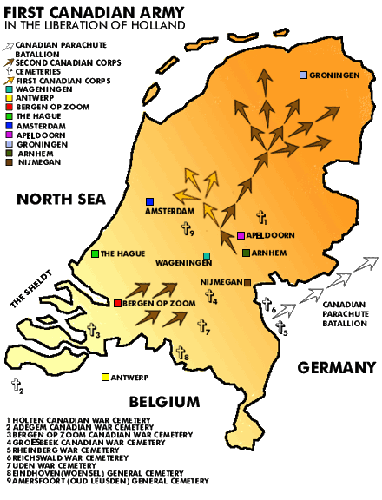
If the story of Canadians actions in April 1945 contains no great decisive battle, it does include a potent mixture of triumph and tragedy. In April 1945 more than 50 soldiers were killed on each of seven days; 114 more were killed between May 1st and the surrender on May 5th, including 12 on the last day of fighting in Europe.
The Allied armies had developed a battle doctrine that called for the expenditure of massive amounts of artillery shells and, if possible, bombs instead of lives. In the final stages of the war, this doctrine could not be applied to Holland so the battles of April were fought using field artillery and mortar as the main firepower to minimise civilian casualties and damages to infrastructures.
Refugees swelled many cities, like Apeldoorn. Once the Canadians had forced the Germans to retreat, the thousands of cheering people that lined the streets to welcome their liberators hindered the Canadian forces from advancing through the newly-abandoned towns. First Canadian Army soldiers liberated numerous other cities like Zutphen, Warnsfeld, Leesten and Zwolle.
The fight for the city of Groningen was a different story. A Dutch SS battalion with little to lose joined miscellaneous German units in a determined defence of the city. 7th brigade was sent into the main battle while the 5th brigade attacked from the west. The Essex Scottish used the Kangaroos to rush a bridge and penetrate the city’s southern edge. Then the Royal Hamilton light Infantry fought a fierce hand-to-hand engagement to gain the railway station. Machines guns covered the streets, and snipers, including SS men in civilian clothes, harassed the Canadians. The Dutch resistance helped where it could. Second division suffered 209 casualties while liberating Groningen.
Alexandre Carette, MA University of Montreal, attended the battlefield study tour of the Canadian Battlefields Foundation in 2004. These are his comments about Groningen:
“My visit of Groningen was memorable. The walking tour of the city was led by Evert Steiber, a Dutch member and friend of the Canadian Battlefields Foundation. He led us through the same route taken by our soldiers in 1945 and explained in details, with a selection of maps, all the challenges the Canadians faced in liberating this city of Northern Holland. We were in Groningen during the ceremonies commemorating the 60th anniversary of the liberation of the Netherlands and when we arrived in the city’s main square we could hear the Canadian National Anthem played on the church’s bells – evidence that the sacrifices of our soldiers have not been forgotten. Today’s Canadian Forces talk constantly of the challenges of the “3 Block War,” but that’s what the liberation of Groningen was, a fight in which the soldiers at the sharp end were involved in heavy urban combat and a few blocks from them other soldiers were doing humanitarian work. This demonstrates the importance of understanding the past so we can make better sense of the present.”
